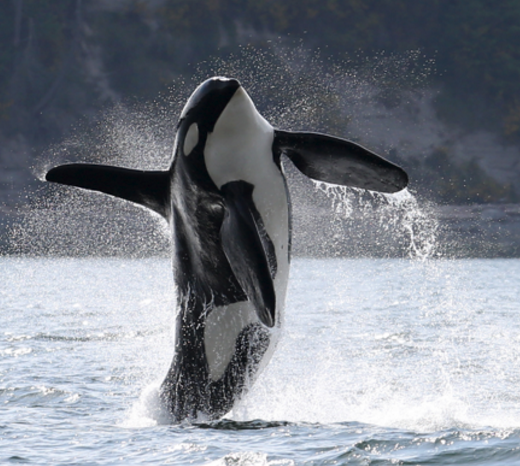 WHEN OUR ORCA STARVE
WHEN OUR ORCA STARVE
DAVID NEIWERT: Victoria photographer Mark Malleson took this photograph of the Southern Resident killer whale known as J-34, or Doublestuf, breaching while he was in the interior waters of the Salish Sea this spring. It’s a remarkable and frightening photo for orca lovers, because the male orca’s ribs appear to be protruding prominently.
That’s abnormal, especially for a resident killer whale at this time of year, when the orcas are typically well fed after a winter of preying on Chinook salmon. And so Malleson’s photo set off a number of alarm bells in the Northwest whale-watching community as it circulated on social media.
Subsequent photos taken of J-34 and his pod from a scientific drone suggested that, while the whales weren’t particularly plump, their girth was within their normal range. Nonetheless, veteran whale scientist Ken Balcomb is blunt about what he is seeing for the Southern Residents long-term: “These whales are starving,” he says. “There simply aren’t enough salmon out there for them to eat.”
There is an established and powerful correlation between salmon abundance and orca populations.
Balcomb and the crew at San Juan Island’s Center for Whale Research have been observing the Southern Residents foraging this winter and spring, and the behavior has been disconcerting: The whales are much more spread out, meaning they are having to forage harder for individual fish. Many of them appear underfed, he says. It’s an especially alarming development following last year’s “baby boom,” in which nine new calves were born into the population, one of whom has apparently already vanished and is presumed dead.
Normally, at this time of year, the Southern Residents are being relatively well fed, since they typically hang out along the Continental Shelf between northern California and British Columbia for the winter and spring months, dining on the large runs of returning Chinook. Many of them spend inordinate amounts of time at the mouth of the Columbia River in the winter.
There is an established and powerful correlation between salmon abundance and orca populations. The uptick in Chinook runs of the past few years on the Columbia/Lower Snake have been linked to the recent orca baby boom.
The spike in salmon numbers is largely attributed to good ocean conditions for the past 12 years, and to some degree to a federal court ruling requiring the Bonneville Power Administration to spill water over Columbia and lower Snake River dams at key times of the year to aid migrating salmon smolt in their downstream journey. But it is the continuing presence of those same four dams — Ice Harbor, Lower Monumental, Little Goose, and Lower Granite, located on the Snake between the Tri-Cities of Pasco, Kennewick, and Richland and Lewiston, Idaho — that may ultimately doom the Southern Resident orca population.